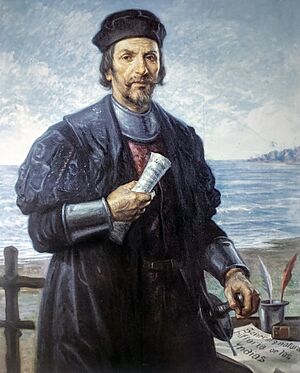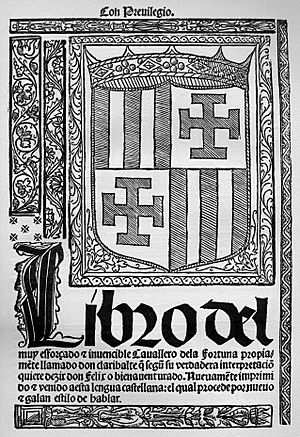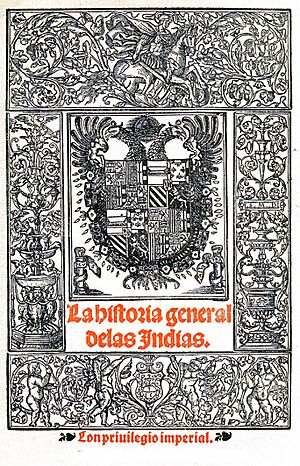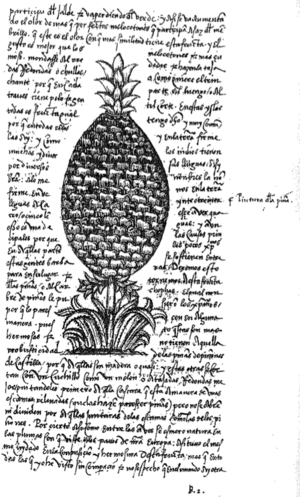Gonzalo Fernández de Oviedo y Valdés facts for kids
Gonzalo Fernández de Oviedo y Valdés (born August 1478 – died 1557), often called Oviedo, was an important Spanish soldier, writer, and historian. He was also interested in plants and helped settle new lands. Oviedo took part in Spain's exploration and settlement of the West Indies. He arrived there just a few years after Christopher Columbus first reached the islands in 1492. Oviedo's famous book, Historia general de las Indias, is one of the few original sources about this time. It was first published in 1535, building on his earlier summary from 1526. Parts of his book were very popular in the 1500s and were translated into Spanish, English, Italian, and French. His writings taught Europeans about things like the hammock, the pineapple, and tobacco. He also wrote important descriptions of the native people living in the region.
Contents
Oviedo's Early Life
Oviedo was born in Madrid, Spain. His family came from Asturias. He grew up and was educated at the royal court of King Ferdinand II of Aragon and Queen Isabella I of Castile. From about age fourteen, he was a page, or assistant, to their son, Prince John, Prince of Asturias. After the Prince died in 1497, Oviedo spent three years in Italy. He then returned to Spain to work for the growing Spanish empire. Oviedo was married twice. His first wife, Margarite de Vergara, died during childbirth. He later married Isabel de Aguilar. Sadly, Isabel and their children passed away a few years after joining Oviedo in America.
Life in the Caribbean
In 1514, Oviedo was given an important job in Santo Domingo. He became the supervisor of gold smelting, which means he oversaw the process of melting gold. When he returned to Spain in 1523, he was named the official historian of the West Indies. He traveled to the Americas five more times before he died in Valladolid, Spain, in 1557. At one point, he was put in charge of the Fortaleza Ozama, a strong fort in Santo Domingo, Dominican Republic. Today, there is a large statue of him there, which was a gift from a King of Spain.
Oviedo's Writings
Oviedo's first book was a chivalric romance called Libro del muy esforzado e invencible caballero Don Claribalte. This type of story is about brave knights and their adventures. It was published in 1519 in Valencia, Spain. In the book's introduction, Oviedo explained that he wrote it while he was in Santo Domingo. This makes it special because it is believed to be the first literary work ever created in the New World.
Oviedo later wrote two very important and long books. Most of these were not published until about 300 years after he died. These books were La historia general y natural de las Indias and Las Quinquagenas de la nobleza de España. The Quinquagenas is a collection of interesting stories and advice about important people of his time.
General History of the Indies
Oviedo first published a shorter version of his main work, called La Natural hystoria de las Indias, in 1526. This shorter book is often called the Sumario. It was translated into Italian in 1534, French in 1545, and English in 1555. This 108-page book had only a few pictures, but it did include one of a hammock.
In 1535, the first part of his longer and more detailed book, Historia general de las Indias, was printed in Seville. Oviedo planned for two more parts. He kept working on the later parts and revising the first part until he died in 1557.
The Historia gives a lot of information that Oviedo gathered himself. Another writer from that time, Bartolomé de las Casas, disagreed with Oviedo's views. Las Casas said that Oviedo's book contained many untrue things. However, the Seville edition of the Historia was widely read in English and French versions. Through this book, Europeans learned about many new things from the Americas. These included the hammock, pineapple, tobacco, and barbecue. The first known drawing of a pineapple is also credited to Oviedo.
Extinct Animals of Hispaniola
Oviedo's General History of the Indies is very interesting for its descriptions of animals found on the island of Hispaniola. Some of these animals became extinct between Oviedo's time and when modern science developed. According to Oviedo, the only native land mammals on the island (besides rats and mice, which Europeans brought) were:
- The hutia: This animal was gray and had four legs. It looked like a rabbit but was smaller, with smaller ears and a tail like a rat. Native people and Spaniards hunted it with dogs. By Oviedo's time, it was "no longer found except very rarely."
- The quemi: This animal was similar to the hutia in color and looks, but it was much larger, about the size of a medium dog. People also ate it. Oviedo believed it was already extinct when he wrote about it.
- The mohuy: This animal was also similar to the hutia but smaller and paler. It had thick, coarse hair that stood up on its back. People who ate its meat thought it was the best, and the island's chiefs, called caciques, valued it highly.
- The cori: This was the domestic guinea pig. People raised it for food. It was probably brought to the island by the Spanish from South America.
- The mute dog (perro mudo): This was a Pre-Columbian dog that could not bark. It had upright ears and came in all kinds of hair lengths and colors, like modern domestic dogs. Native people kept these dogs in their homes and used them to hunt hutias. However, European dogs were better hunters. This dog was extinct on Hispaniola when Oviedo wrote about it. But he saw similar dogs in native villages on other islands and in parts of North America.
See also
 In Spanish: Gonzalo Fernández de Oviedo para niños
In Spanish: Gonzalo Fernández de Oviedo para niños





